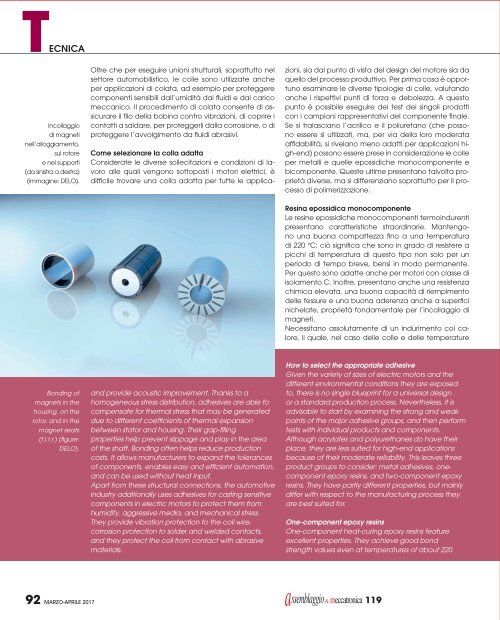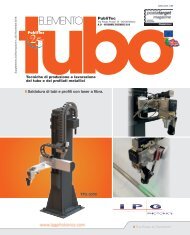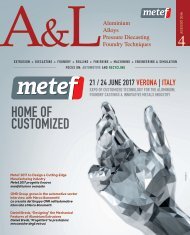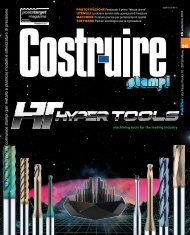ASSEMBLAGGIO_n119_MARZO_APRILE_2017
You also want an ePaper? Increase the reach of your titles
YUMPU automatically turns print PDFs into web optimized ePapers that Google loves.
TECNICA<br />
Incollaggio<br />
di magneti<br />
nell’alloggiamento,<br />
sul rotore<br />
e nei supporti<br />
(da sinistra a destra)<br />
(immagine: DELO).<br />
Oltre che per eseguire unioni strutturali, soprattutto nel<br />
settore automobilistico, le colle sono utilizzate anche<br />
per applicazioni di colata, ad esempio per proteggere<br />
componenti sensibili dall’umidità dai fluidi e dal carico<br />
meccanico. Il procedimento di colata consente di assicurare<br />
il filo della bobina contro vibrazioni, di coprire i<br />
contatti a saldare, per proteggerli dalla corrosione, o di<br />
proteggere l’avvolgimento da fluidi abrasivi.<br />
Come selezionare la colla adatta<br />
Considerate le diverse sollecitazioni e condizioni di lavoro<br />
alle quali vengono sottoposti i motori elettrici, è<br />
difficile trovare una colla adatta per tutte le applicazioni,<br />
sia dal punto di vista del design del motore sia da<br />
quello del processo produttivo. Per prima cosa è opportuno<br />
esaminare le diverse tipologie di colle, valutando<br />
anche i rispettivi punti di forza e debolezza. A questo<br />
punto è possibile eseguire dei test dei singoli prodotti<br />
con i campioni rappresentativi del componente finale.<br />
Se si tralasciano l’acrilico e il poliuretano (che possono<br />
essere sì utilizzati, ma, per via della loro moderata<br />
affidabilità, si rivelano meno adatti per applicazioni high-end)<br />
possono essere prese in considerazione le colle<br />
per metalli e quelle epossidiche monocomponente e<br />
bicomponente. Queste ultime presentano talvolta proprietà<br />
diverse, ma si differenziano soprattutto per il processo<br />
di polimerizzazione.<br />
Resina epossidica monocomponente<br />
Le resine epossidiche monocomponenti termoindurenti<br />
presentano caratteristiche straordinarie. Mantengono<br />
una buona compattezza fino a una temperatura<br />
di 220 °C; ciò significa che sono in grado di resistere a<br />
picchi di temperatura di questo tipo non solo per un<br />
periodo di tempo breve, bensì in modo permanente.<br />
Per questo sono adatte anche per motori con classe di<br />
isolamento C. Inoltre, presentano anche una resistenza<br />
chimica elevata, una buona capacità di riempimento<br />
delle fessure e una buona aderenza anche a superfici<br />
nichelate, proprietà fondamentale per l’incollaggio di<br />
magneti.<br />
Necessitano assolutamente di un indurimento col calore,<br />
il quale, nel caso delle colle e delle temperature<br />
Bonding of<br />
magnets in the<br />
housing, on the<br />
rotor, and in the<br />
magnet seats<br />
(f.l.t.r.) (figure:<br />
DELO).<br />
and provide acoustic improvement. Thanks to a<br />
homogeneous stress distribution, adhesives are able to<br />
compensate for thermal stress that may be generated<br />
due to different coefficients of thermal expansion<br />
between stator and housing. Their gap-filling<br />
properties help prevent slippage and play in the area<br />
of the shaft. Bonding often helps reduce production<br />
costs. It allows manufacturers to expand the tolerances<br />
of components, enables easy and efficient automation,<br />
and can be used without heat input.<br />
Apart from these structural connections, the automotive<br />
industry additionally uses adhesives for casting sensitive<br />
components in electric motors to protect them from<br />
humidity, aggressive media, and mechanical stress.<br />
They provide vibration protection to the coil wire,<br />
corrosion protection to solder and welded contacts,<br />
and they protect the coil from contact with abrasive<br />
materials.<br />
How to select the appropriate adhesive<br />
Given the variety of sizes of electric motors and the<br />
different environmental conditions they are exposed<br />
to, there is no single blueprint for a universal design<br />
or a standard production process. Nevertheless, it is<br />
advisable to start by examining the strong and weak<br />
points of the major adhesive groups, and then perform<br />
tests with individual products and components.<br />
Although acrylates and polyurethanes do have their<br />
place, they are less suited for high-end applications<br />
because of their moderate reliability. This leaves three<br />
product groups to consider: metal adhesives, onecomponent<br />
epoxy resins, and two-component epoxy<br />
resins. They have partly different properties, but mainly<br />
differ with respect to the manufacturing process they<br />
are best suited for.<br />
One-component epoxy resins<br />
One-component heat-curing epoxy resins feature<br />
excellent properties. They achieve good bond<br />
strength values even at temperatures of about 220<br />
92 <strong>MARZO</strong>-<strong>APRILE</strong> <strong>2017</strong> & meccatronica 119





